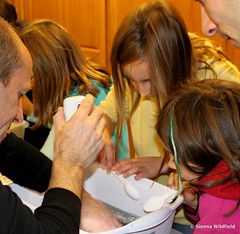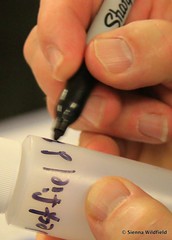From Bugs to Eagles: Understanding River Ecosystems
How many times have you looked at a river thinking, how beautiful—and pulled out your camera to capture the swells of whitewater, a striking blue heron, or blazing maple tree in the autumn overhanging its banks?
A river is not just beautiful, though; it’s alive, and those who witness this life, this bios, never look at or appreciate a river the same way again. Based out of Westhampton, MA, the Biocitizen School has been training volunteers to see and understand a river’s bios by teaching them how to do Rapid Bioassessments. We net the benthic macroinvertebrates (underwater bugs), and by inventorying them, we can quickly assess how alive the river is.

Identifying a sample of benthic macro invertebrates (water bugs) taken during a Rapid Bioassessment, from the Westfield River.
Stonefly Nymphs: Indicators of a Healthy River Ecosystem
Stonefly nymphs are a bug we want to catch. They are a primary food source for brook trout and, like trout, require clear, clean, cold oxygen-rich water. If there is too much nitrogen or potassium (from fertilizer runoff) in the water, algae will bloom and suck the oxygen out of the river. You won’t find many stonefly nymphs—and therefore trout.

Kurt helps kids sort through a sample that included stonefly nymphs. Stoneflies give an abundance of food to trout, feeding the Bald Eagles on the river.
Rapid Bioassessment: Keeping a Check on River Health Year-Round
By doing a Rapid Bioassessment, you can monitor a river that is dear to you, year after year, to ensure that it’s healthy—and stays that way. These “bug inventories” are sent to the DEP, where they are checked and logged, becoming part of the public historical record. Such records are invaluable for scientific research and land-use decision-making.

Families inventoried their samples, giving proof that the oxygen-rich water was of exceptional quality!
Training Families in River Ecology: A Day at the Westfield River
I had the pleasure of training a few families on the east branch of the Westfield River, where Stevenson’s Brook meets the river in West Chesterfield, MA. One of my favorite moments occurred at the end after we had identified our last worm species and had the proof we needed to judge the water of “exceptional quality.” “We have bald eagles on the Westfield,” I was told; “They fly up and down the river: must have five-foot wingspans, seem almost as big as a person!” Yes. All of us lucky families have big, beautiful bald eagles living near us. Because the water is oxygen-rich, there’s an abundance of stoneflies, which gives us an abundance of trout, which the bald eagles find yummy: enough fish so they can nest and raise their families here, too!
Kurt Heidinger, Executive Director of Biocitizen School of Westhampton, MA. Find out more about Biocitizens and how your family can get involved with Rapid Bioassessment, visit www.biocitizen.org.
 Hilltown Families
Hilltown Families 





























http://twitter.com/#!/MassAudubon/status/2094333545160705